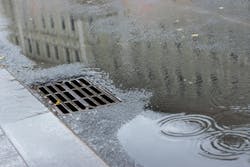Stormwater has recently gained increasing attention as a potential migration pathway for perfluorooctanoic acids (PFAS). For example, stormwater has been shown to wash off and transport Aqueous Film Forming Foam (AFFF), PFAS from other PFAS sources, and/or impacted surface soils to surface water bodies at PFAS-impacted sites. In instances where these stormwater discharges are covered under National Pollutant Discharge Elimination System (NPDES) permits, receiving water limits often require discharges not cause or contribute to water quality standards (WQS) exceedances. However, the applicable WQS depend on the receiving water type (e.g., marine versus freshwater) and beneficial use (e.g., municipal supply versus aquatic life). In most US states, formal, enforceable WQS have not yet been developed for PFAS.
WQS standards throughout the states
Several states have been active in developing drinking water notification, advisory, or reporting levels for PFAS, and some states have also developed fish consumption advisory levels. However, few enforceable WQS have been established, especially for aquatic life and human health (consumption of organisms). In California, environmental screening levels from the San Francisco region have been developed recently and have the potential to be referenced by other regions for setting cleanup levels for soil, groundwater, and, potentially, surface waters discharges as well. WQS and screening levels differ in that WQS must go through a public comment process and are typically the basis of NPDES water quality-based effluent limits.
As of May 2020, the State Water Resources Control Board (SWRCB) in California has issued investigative orders to various types of facilities with high potential for PFAS presence (i.e., “high risk”), including landfills, airports, and chrome platers. The orders to chrome platers were the first in the state to include stormwater and aerial deposition sampling. Geosyntec Consultants also recently supported the SWRCB on the development of statewide guidance for stormwater dry wells, which included a literature review on PFAS in stormwater and an assessment of risks to groundwater contamination from stormwater infiltration through dry wells. Based on this guidance, it is expected that the SWRCB will require “high risk” facilities with potential PFAS sources to coordinate with regional water boards and potentially sample stormwater for PFAS prior to installing new dry wells.
PFAS research lessons
Lessons learned from ongoing Geosyntec stormwater PFAS treatment projects and research provide key takeaways:
Anticipated WQS Magnitudes
Ecological risk-based thresholds for aquatic life protection are increasingly being reported, such as through recent research for the Department of Defense (DoD). These aquatic life values are higher than many state’s drinking water thresholds. This is not likely to be true of human health thresholds for consumption of organisms, therefore future WQS applicable to non-municipal supply receiving waters (both surface and groundwaters) may not be less stringent than drinking water standards.
Abundance of PFAS in Urban Stormwater
Perfluorooctanoic acid (PFOA)/PFOS are typically detected in urban stormwater runoff, with residential runoff unlikely to exceed EPA drinking water thresholds, but with the potential to exceed California’s notification levels, and commercial/industrial runoff likely to exceed both EPA and California levels. Therefore, there is potential for stormwater discharges to present a risk of WQS exceedance, particularly to receiving waters with minimal dilution (e.g., ephemeral drainages).
Stormwater Treatment Selection and Performance
Despite a lack of performance data for conventional structural Best Management Practices (BMPs) for PFAS, based on the physiochemical properties of PFAS, these BMPs are expected to have limited effectiveness. An exception may be if the BMP includes effective pretreatment, carbon media amendment (with frequent maintenance), and outlet control (for increased contact time).
- At PFAS cleanup sites where stormwater remediation is required, active treatment systems are often needed. These systems are powered, provide equalization storage, robust pretreatment (e.g., chemical-flocculant addition or microfiltration), granular activated carbon (GAC), and/or ion exchange.
- Because of the range of organic-carbon partitioning coefficient (Koc) values of different PFAS (e.g., PFOS has medium-high Koc and PFOA has low Koc), the average fractions of PFAS that are attached to suspended solids—and are therefore more controllable via erosion/sediment control and conventional natural treatment BMPs such as those found in most municipal stormwater BMP design manuals—are highly variable. As a result, treatment efficacy will vary by PFAS. For low Koc PFAS (like PFOA), erosion/sediment control and conventional natural treatment control BMPs are expected to have marginal effectiveness and infiltration BMPs could present a risk for groundwater contamination (due to their mobility through the vadose zone). Therefore, active treatment systems, such as GAC-based systems, may be preferred. However, the low capture efficiency and rapid breakthrough could translate to a high replacement frequency and high O&M cost that should be factored in during treatment option comparison.
- Research on conventional stormwater treatment controls is ongoing and needed. For example, Geosyntec is collaborating with Texas Tech University and Stanford researchers on stormwater treatment BMP performance testing for the DoD for various less-studied pollutants including PFAS, with an emphasis on reducing risk of recontaminating sediment cleanup sites. More such studies are needed, and the data should be made public through inventories like the International Stormwater BMP Database (www.bmpdatabase.org).
- More performance data are needed on the effectiveness of source controls—such as roof coating, pavement resurfacing, and surface soil stabilization—as a means of controlling legacy PFAS residues that reside on surfaces and soils.
Much of this material is taken from Geosyntec presentations on PFAS in Stormwater at the 2019 California Stormwater Quality Association (CASQA) Conference and a 2020 California Groundwater Resources Association (GRA) webinar series on PFAS. These presentations can be made available to our professional colleagues upon request.







